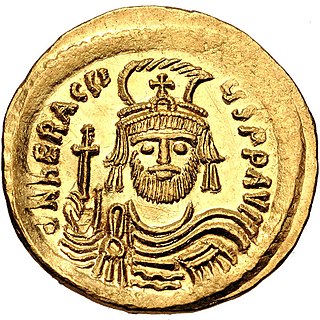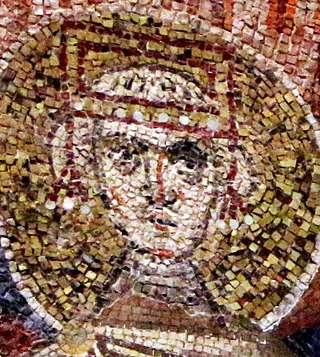
Heraclius was Byzantine emperor from 610 to 641. His rise to power began in 608, when he and his father, Heraclius the Elder, the Exarch of Africa, led a revolt against the unpopular emperor Phocas.

Year 641 (DCXLI) was a common year starting on Monday of the Julian calendar. The denomination 641 for this year has been used since the early medieval period, when the Anno Domini calendar era became the prevalent method in Europe for naming years.

Heraclius, known by the diminutive Heraclonas or Heracleonas, and sometimes called Heraclius II, was briefly Byzantine emperor in 641.

Heraclius Constantine, often enumerated as Constantine III, was one of the shortest reigning Byzantine emperors, ruling for three months in 641. He was the eldest son of Emperor Heraclius and his first wife Eudokia.

Constans II, also called "the Bearded", was the Byzantine emperor from 641 to 668. Constans was the last attested emperor to serve as consul, in 642, although the office continued to exist until the reign of Leo VI the Wise. His religious policy saw him steering a middle line in disputes between the Orthodoxy and Monothelitism by refusing to persecute either and prohibited discussion of the natures of Jesus Christ under the Type of Constans in 648. His reign coincided with Muslim invasions under, Umar, Uthman, and Mu'awiya I in the late 640s to 660s. Constans was the first emperor to visit Rome since the fall of the Western Roman Empire in 476, and the last one to visit Rome while the Empire still held it.

Constantine IV, called the Younger and often incorrectly the Bearded out of confusion with his father, was Byzantine emperor from 668 to 685. His reign saw the first serious check to nearly 50 years of uninterrupted Islamic expansion, most notably when he successfully defended Constantinople from the Arabs, and the temporary stabilization of the Byzantine Empire after decades of war, defeats, and civil strife. His calling of the Sixth Ecumenical Council saw the end of the monothelitism controversy in the Byzantine Empire; for this, he is venerated as a saint in the Eastern Orthodox Church, with his feast day on September 3.

Tiberius III, born Apsimar, was Byzantine emperor from 698 to 705. Little is known about his early life, other than that he was a droungarios, a mid-level commander, who served in the Cibyrrhaeot Theme. In 696, Tiberius was part of an army sent by Byzantine Emperor Leontius to retake the North African city of Carthage, which had been captured by the Arab Umayyads. After seizing the city, this army was pushed back by Umayyad reinforcements and retreated to the island of Crete. As they feared the wrath of Leontius, some officers killed their commander, John the Patrician, and declared Tiberius the emperor. Tiberius swiftly gathered a fleet and sailed for Constantinople, where he then deposed Leontius. Tiberius did not attempt to retake Byzantine Africa from the Umayyads, but campaigned against them along the eastern border with some success. In 705, former emperor Justinian II, who had been deposed by Leontius, led an army of Slavs and Bulgars from the First Bulgarian Empire to Constantinople, and after entering the city secretly, deposed Tiberius. Tiberius fled to Bithynia, but was captured a few months later and beheaded by Justinian between August 705 and February 706. His body was initially thrown into the sea, but was later recovered and buried in a church on the island of Prote.

The Byzantine senate or Eastern Roman senate was a continuation of the Roman Senate, established in the 4th century by Constantine I. It survived for centuries, but the senate's powers varied greatly during its history and gradually diminished until its eventual disappearance in the 14th century.
Pyrrhus was the ecumenical patriarch of Constantinople from 20 December 638 to 29 September 641, and again from 9 January to 1 June 654.

Martina was an empress of the Byzantine Empire, the second wife of her uncle the emperor Heraclius, and regent in 641 with her son. She was a daughter of Maria, Heraclius' sister, and a certain Martinus. Maria and Heraclius were children of Heraclius the Elder and his wife Epiphania according to the chronicle of Theophanes the Confessor.
Cyrus of Alexandria was a prominent figure in the 7th century. He served as a Greek Orthodox Patriarch of Alexandria and held the position of the second-last Byzantine prefect of Egypt. Notably, he played a significant role in the development of monothelitism. Cyrus died in Alexandria on March 21, 642.
The Excubitors were founded in c. 460 as an imperial guard-unit by the Byzantine emperor Leo I the Thracian. The 300-strong force, originally recruited from among the warlike mountain tribe of the Isaurians, replaced the older Scholae Palatinae as the main imperial bodyguards. The Excubitors remained an active military unit for the next two centuries, although, as imperial bodyguards, they did not often go on campaign. Their commander, the Count of the Excubitors, soon acquired great influence. Justin I was able to use this position to rise to the throne in 518, and thereafter the Counts of the Excubitors were among the main political power-holders of their day; two more, Tiberius II Constantine and Maurice, rose to become emperors in the late 6th century.

The Byzantine Empire was ruled by emperors of the dynasty of Heraclius between 610 and 711. The Heraclians presided over a period of cataclysmic events that were a watershed in the history of the Empire and the world. Heraclius, the founder of his dynasty, was of Armenian and Cappadocian (Greek) origin. At the beginning of the dynasty, the Empire's culture was still essentially Ancient Roman, dominating the Mediterranean and harbouring a prosperous Late Antique urban civilization. This world was shattered by successive invasions, which resulted in extensive territorial losses, financial collapse and plagues that depopulated the cities, while religious controversies and rebellions further weakened the Empire.
Fausta was the Byzantine empress as the wife of Constans II, when they married in 642.
Gregoria was the Byzantine empress as the wife of Constantine III. She participated in the minority regency government of her son, Constans II, in 641–650.
Heraclius was the Byzantine emperor from 610 to 641.
Valentinus, sometimes anglicized as Valentine, was a Byzantine usurper of probable Armenian extraction, who served under emperor Constans II from 641 until 644 or 645. He rose to prominence under Heraclius Constantine, who appointed him to secure the succession of his son Heraclius to the throne, at the cost of Heraclonas and Martina. Valentinus managed to successfully depose them, along with Heraclonas's brothers David Tiberius and Martinus; this left Constans as sole ruler. Valentinus became the boy's regent, becoming the most powerful man in the empire. Following a failed military campaign against the Arabs, ties between him and Constans became increasingly hostile, such that in 644 or 645, Valentinus attempted to become augustus (emperor) and depose Constans. This failed, and Valentinus was lynched along with his envoy Antoninus.

Heraclius was Byzantine co-emperor from 659 to 681. He was the son of Emperor Constans II and Fausta, who was elevated in 659, before his father departed for Italy. After the death of Constans, Heraclius' brother Constantine IV ascended the throne as senior emperor. Constantine attempted to have both Heraclius and Tiberius removed as co-emperors. However, this sparked a popular revolt in 681. Constantine ended the revolt by promising to accede to the demands of the rebels, sending them home, but bringing their leaders into Constantinople. Once there, Constantine had them executed, then imprisoned Tiberius and Heraclius and had their noses slit, after which point they disappear from history.

Tiberius was Byzantine co-emperor from 659 to 681. He was the son of Constans II and Fausta, who was elevated in 659, before his father departed for Italy. After the death of Constans, Tiberius' brother Constantine IV, ascended the throne as senior emperor. Constantine attempted to have both Tiberius and Heraclius removed as co-emperors, which sparked a popular revolt, in 681. Constantine ended the revolt by promising to accede to the demands of the rebels, sending them home, but bringing their leaders into Constantinople. Once there, Constantine had them executed, then imprisoned Tiberius and Heraclius and had them mutilated, after which point they disappear from history.

David was one of three co-emperors of Byzantium for a few months in late 641, and had the regnal name Tiberius. David was the son of Emperor Heraclius and his wife and niece Empress Martina. He was born after the emperor and empress had visited Jerusalem and his given name reflects a deliberate attempt to link the imperial family with the Biblical David. The David Plates, which depict the life of King David, may likewise have been created for the young prince or to commemorate his birth. David was given the senior court title caesar in 638, in a ceremony during which he received the kamelaukion cap previously worn by his older brother Heraclonas.














